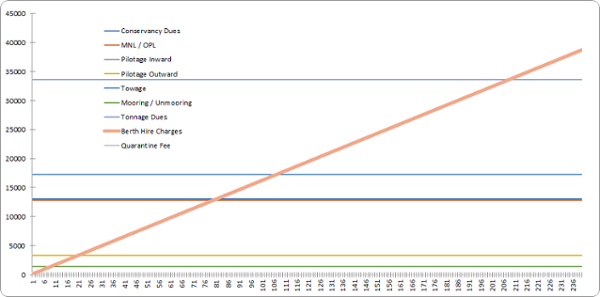 _x000D_
_x000D_
By Mark Franklin 2018-11-27 02:00:48
_x000D_
 There are inherent difficulties in accurately predicting the port costs, which forms a significant part of the voyage costs. The accuracy of these calculations gives the chartering team the ability to more precisely calculate the potential profit of the voyage. In some cases, large savings can be made by understanding what really affects the basis of calculations from the tariff.
There are inherent difficulties in accurately predicting the port costs, which forms a significant part of the voyage costs. The accuracy of these calculations gives the chartering team the ability to more precisely calculate the potential profit of the voyage. In some cases, large savings can be made by understanding what really affects the basis of calculations from the tariff.
_x000D_
Firstly, it is increasingly apparent that these costs need to be analyzed at a terminal or berth level. There can be significant variances in costs between different terminals within a port. However, as this information is often not available when fixing a cargo, the port-level data usually has to suffice.
_x000D_
Our studies into the tariff structures reveals that there are generally four methods of calculation on the most significant costs that influence the overall cost.
_x000D_
Characteristically ports have a linear cost profile, wherein the longer the vessel stays, the cost increases proportional to the time alongside.
_x000D_

_x000D_
However, many tariffs show a significant increase after a set period of time alongside (i.e. 72 hours) This is an important one to monitor if the opportunity to sail within the 72 hours exists.
_x000D_

_x000D_
The third example is the “stepped” cost – where costs increase in slabs. When plotted on a graph the lines appear like steps rising from left to right. These are also interesting in terms of potential savings as departing prior to the next slab jump could make a compelling saving – or help decide if any overtime should be paid.
_x000D_

_x000D_
The last, and least common, are fixed cost tariffs where only minor increases occur if the stay far exceeds the expectation. A good insight if you know the cost remains roughly the same regardless of time spent – it could be an ideal place for making repairs.
_x000D_
Knowing how costs behave is important for decision making. You will want to know how costs will increase or how costs could decrease at variable times. There’s still a huge amount of variables within these tariff structures, with dependencies on vessel type, size, last or next port, frequency of calls, flag and environmental rating, amongst many others. It’s a constantly evolving list of rules – to which we add daily.
_x000D_
To know about port cost management services, send your details here.
_x000D_
Mark Franklin is Deputy Managing Director at DA-Desk.
_x000D_
The opinions expressed herein are the author’s and not necessarily those of The Maritime Executive.
_x000D_
source: www.maritime-executive.com
_x000D_
_x000D_
_x000D_


